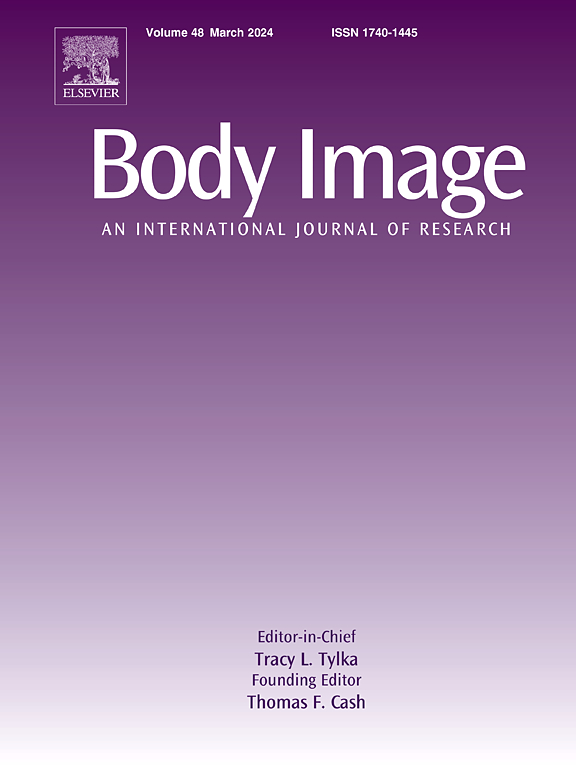Developing a digital mindfulness-based intervention to improve body image and reduce risk factors for disordered eating: Integrating theory, evidence, and the person-based approach
IF 5.4
1区 心理学
Q1 PSYCHIATRY
引用次数: 0
Abstract
Mindfulness-based interventions (MBIs) show promise in improving body image and reducing risk factors for disordered eating, and their digital adaptation offers scalable dissemination. However, low engagement rates in digital MBIs highlight the need for user-centred development. The person-based approach offers a systematic framework for improving engagement by integrating evidence, theory, and users’ perspectives. This paper describes the application of the person-based approach in developing a digital MBI to reduce risk factors for disordered eating in young people. Intervention development occurred in two iterative phases. In Phase 1, we defined the theoretical context and conducted both a qualitative evidence synthesis and a survey study with a qualitative focus to explore the needs, challenges, and perspectives of the target population. In Phase 2, we developed and refined a prototype based on initial feasibility and acceptability testing through advisory group consultation and think-aloud interviews. These informed the guiding principles and logic model. Our theoretical framework identified the skills of decentred awareness and acceptance, emotion regulation, and self-compassion as key intervention components. Determinants of engagement included negative responses to personal practice, difficulty with habit formation, and social support. Survey findings highlighted the need to address misconceptions about body image, particularly the belief that it refers solely to physical appearance and can be improved through appearance-focused strategies. Feedback from the advisory group helped ensure the intervention was clear, user-friendly, and motivating. This novel integration of theory, evidence, and user-centred design methods provides a replicable model for developing engaging, scalable interventions to reduce disordered eating risk.
开发以数字正念为基础的干预措施,改善身体形象,减少饮食失调的风险因素:整合理论、证据和以人为本的方法
正念干预(mbi)在改善身体形象和减少饮食失调的风险因素方面显示出希望,它们的数字化适应提供了可扩展的传播。然而,数字mbi的低参与率突出了以用户为中心的开发的必要性。以人为本的方法通过整合证据、理论和用户观点,为提高参与度提供了一个系统框架。本文描述了以人为本的方法在开发数字MBI中的应用,以减少年轻人饮食失调的风险因素。干预开发发生在两个迭代阶段。在第一阶段,我们定义了理论背景,并进行了定性证据综合和定性重点调查研究,以探索目标人群的需求、挑战和观点。在第二阶段,我们通过咨询小组的咨询和畅所欲言的访谈,基于最初的可行性和可接受性测试,开发并完善了原型。这些为指导原则和逻辑模型提供了信息。我们的理论框架确定了非中心意识和接受、情绪调节和自我同情的技能是关键的干预成分。参与的决定因素包括对个人实践的负面反应、习惯形成的困难和社会支持。调查结果强调,有必要纠正人们对身体形象的误解,特别是认为身体形象只指外表,可以通过注重外表的策略来改善。咨询小组的反馈有助于确保干预是明确的、用户友好的和激励的。这种理论、证据和以用户为中心的设计方法的新颖整合为开发有吸引力的、可扩展的干预措施以减少饮食失调风险提供了一个可复制的模型。
本文章由计算机程序翻译,如有差异,请以英文原文为准。
求助全文
约1分钟内获得全文
求助全文
来源期刊

Body Image
Multiple-
CiteScore
8.70
自引率
28.80%
发文量
174
期刊介绍:
Body Image is an international, peer-reviewed journal that publishes high-quality, scientific articles on body image and human physical appearance. Body Image is a multi-faceted concept that refers to persons perceptions and attitudes about their own body, particularly but not exclusively its appearance. The journal invites contributions from a broad range of disciplines-psychological science, other social and behavioral sciences, and medical and health sciences. The journal publishes original research articles, brief research reports, theoretical and review papers, and science-based practitioner reports of interest. Dissertation abstracts are also published online, and the journal gives an annual award for the best doctoral dissertation in this field.
 求助内容:
求助内容: 应助结果提醒方式:
应助结果提醒方式:


